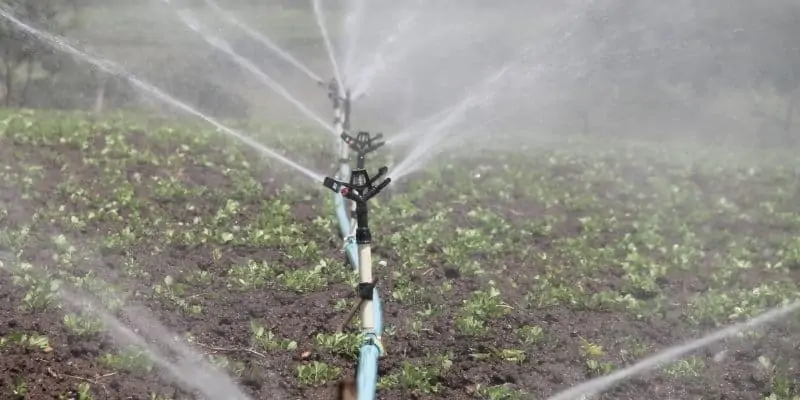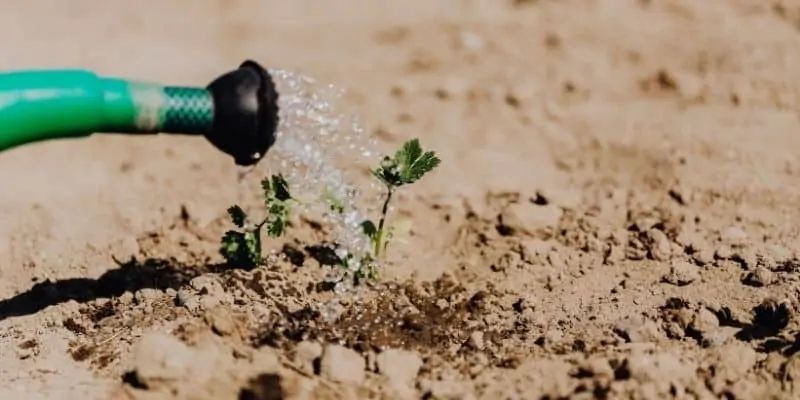Really Can Plants Drown? What do you think- Interesting question isn’t it? Indeed it is a simple yet very interesting question to learn. Last week a 16-year-old college student from Michigan asked this question in the discussion. It draws my attention more once a hot debate started among several members about the facts. Finally, I decided to share what I know and what’s true to my knowledge about plants. And yes for a bonus I’ll also discuss How to Save a Drowning Plant? you can check out an interesting gadget called a plant health sensor on Amazon.

Check out my previous post: How Do I Start Composting? at my Home Garden
What does drowning mean for a Plant?
Falling in water and sinking can be the worst nightmare for lost anyone. We generally state the term Drowning with sinking in water. Whether it’s a human or a plant, if it drowns and no ones is there to save then death is inevitable.
OK, I am not here to discuss these creepy facts yet it’s a fact that we think of drowning as death. Is it so? Nope Death is the final and unfortunate outcome of drowning.
Drowning itself does not resemble death. In fact, Drowning is a state of acts that represent sinking into the water. Every change that occurs within a body whether a plant or animal from the point of sinking till it dies is drowning.
Now, what exactly does drowning mean for plants? It states all the changes that accus due to overwatering that can of course kill the plant. Sometimes it can be quick but most of the time you have to wait to observe the changes caused by drowning in your plants.
Also read: How is Over Irrigation Damaging the soil?
Can Plants Drown?
Yes, just like any living creature plants can also drown. Although there are several stages of this phenomenon still the ultimate result is the death of the plant.
Now it is an obvious fact that plants cannot walk to the pond, river, or any sea to jump and drown. It would really be a creepy scene to watch. Ok jokes apart.
We know that plat cannot do anything that can lead to their drowning. So It is we humans or nature that can create drowning conditions for the plants.
Overwatering is the main cause of plant drowning. No matter whether you put the excess water or it rained. The ultimate result will be the same. You must know a very interesting fact about plants drowning. There is no need to sink the plant in water to its top just to drown it. Only leaving the roots in soggy soil for a couple of days can drown the plants.
Does it mean all plants can drown in these situations? No certainly not. Nature has adapted to sustain life and believe me, plants are the oldest living creature on the earth. There are natural exceptions all over in the plant kingdom to survive the worst-case scenarios. For example, many plants like Mangroove, hyacinth, swamp bamboo, reed grass can easily survive in flooded land for years.
How long does it take to drown a plant?
It can take anywhere from 2 days to 6 months. Yes, it’s really very long-range coz there is literally an uncountable number of plants out there in wild. All of them react differently with the amount of water on the face.
Some plants can drown in just a couple of overwatering sessions i.e., most succulents. While big trees can easily survive a little overwatering a couple of times. In fact, fruiting trees can only drown if they are flooded to the top for a couple of weeks. Even in these conditions, their survival is possible.
Therefore depending on the size, type, conditions, and strength of any plant you can assume a timing anywhere between a couple of days to several months for drowning.
How to know if my plants are Drowning?
Identifying drowning plants is easy especially for common garden flowers and fruit-bearing plants. You can look out for soggy soil around the rootball. If the plant looks pale and droopy even with wet soil then it is definitely due to drowning. The roots are not getting proper oxygen hence the plant is unable to conduct nutritions to the top.
If nothing is done at this stage then the plant will eventually die.
You can use a soil moisture meter to know the level of water in the soil. Some meters can inform you with alarms if the water level is too high or too low.
What are the symptoms of Drowning in Plants?
The symptoms of drowning differ with the amount of water and the plant species. As we have already discussed different plants can tolerate different amounts of water. So they tend to react differently while drowning. Therefore it is pretty difficult to state one or two perfect symptoms of drowning. Instead, we guess this condition with progressive change in the current plant state.
All you need is to observe the following changes to identify a drowning plant.
- Yellowing of leaves after watering.
- Water oozing out of the soil if gently pressed.
- Dropping of new leaves and buds.
- Falling scales or bark in some plant
- Drak brown patch with a foul odor
- Roots growing on the body of the plant
- Fading of sweet fruit taste and fragrance in some flowers
- Reduction in flower and fruit size also indicates slow drowning.
Overall many such changes can be seen in a drowning plant. Sometimes you can find multiple symptoms in any particular plant. Also, you can find some of these symptoms in plants that are not drowning. So it is pretty hard to decide the exact symptom. Yet it is better to identify the soil conditions with the plant health.
Keep in mind these symptoms can also suggest overheating, dehydration, pest attacks, and fungal diseases.
If there is excess waterlogged in the soil around the rootballs then all other problems are due to drowning. Simply avoid overwatering in your lawn and garden. This not only drowns the plants but also attracts lots of pests and fungal diseases. Eventually, all of these conditions can kill your lovely plants.
Can a plant drown in Rain?
Yes, a plant can drown in heavy rain especially if the water collects around the plant root. Although the change of heavy damage is low due to the short tenure of rainfall. Still, it can drown plants that are not adaptable to humid, moist rainy conditions.
Plants like cactus, succulents, and tender veggies are more likely to drown in heavy rain within 2 days. In fact, most cucurbits can easily drown in a couple of days of heavy rainfall.
Although many plants can easily survive even the heaviest of the rains ever experienced. They can simply sustain flooded land for months unless they get submerged completely in water.
Check out this: 13 Tips for Gardening in Rainy Season: Monsoon Gardening
Can We save drowning Plants?
Nw, as we have learned that plants can drown. Then the next important quest to discuss is can we save a drowning plant. Is it possible to save a plant that has already drowned?
The answer is Yes, We can save a drowning plant. More or less it is true that a Drowning plant can be saved unless it has not already died.
Most plants have some natural mechanism to protect themselves from adverse conditions like drowning. They slow down their metabolic activities. Stop all means of resource loss like flowering or fruiting. In this way, they can survive for months without food in a drowned state. Although this timing greatly differs with the plant species.
So if there is life left in the plant, It can be saved. At least you can try to save it with all your resources. Therefore, it is possible to save a drowning plant if you know what exactly to do. You must understand what is the necessary step to take to save the droning plant, and yes you better act fast.

How to Save a Drowning Plant?
- Stop watering once you identify the problem as Drowning. You can adapt to drip irrigation.
- Put extra dry soil mix around wet or soggy rootballs especially for garden plants.
- In containers start with cleaning the drainage holes in the bottom. You can simply use a stick or a screwdriver to punch the holes inside. This will unclog the drainage hole and release the logged water.
- Put the container with soggy soil at a little height above ground. This will allow gravity to drain the water quickly out of the drainage hole.
- You can also tap the side of the container to loosen the soil which releases excess trapped water. It will help the roots to aerate and dry quickly.
- Never place the plant with soggy rootball in direct sun to dry. It will kill the plant instead of saving it.
- Instead, you should keep the drowning plants in partial shade. Remove excess water from the soil.
- Till the soil to loosen its texture and release moisture.
- Once the soil looks fine and wet, not soggy. Simply place the plant in morning sunlight for a couple of hours every day.
- In the worst case, you should take out the plant from the container. Drain the logged water and replace it with a new soil mix.
- Remove any dead, brown stinky leaves and roots. This may require a thorough checkup so look at your plant carefully.
- Once you have removed the damaged portion of the drowning plant. Add some fresh soil mix and sand with 2 spoons of contact fungicide and refill the pot.
- Don’t water or fertilize a drowning plant unless the soil becomes completely dry. There is nothing to do even if the plant looks droopy.
- Once the soil is perfectly dry start watering only once or twice per week. Feed the plants with liquid fertilizer at a low concentration for a couple of weeks.
- This should be enough to save a plant from drowning. If the soil condition is good then you only need to feed the plant properly in time with an adequate dose of sunlight and fertilizers.
Special Tips:
In the worst-case scenario, you can use baby diapers to dry out the soggy soil. Simply tear a diaper and put the silica gel on top of the soil surface. It will drain every drop of excess moisture. Remove these gel balls after a couple of hours. You may have to repeat this step twice or more but trust me it really works magically. The soil will dry in no time and you will get a chance to save your drowning plants.
Read this: Everything to know about raised garden beds
Grow your plants in a raised bed garden t avoid water logging during the rainy season. This can greatly reduce the chance of drowning.
Also, Put some dry mulch at the bottom of the container before planting anything in it. This will maintain a buffer for water and air for proper root growth.
Keep reading and keep gardening!

